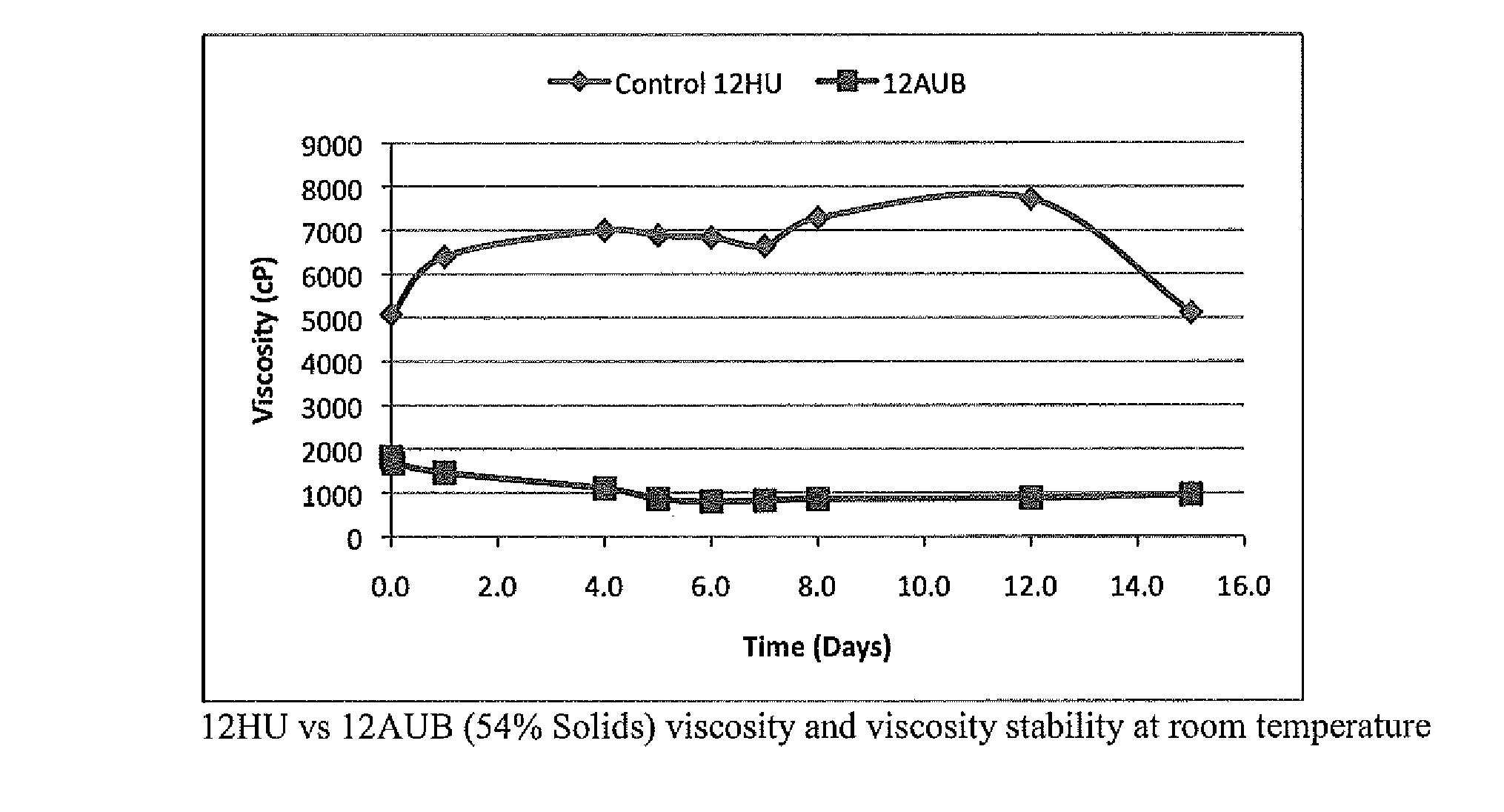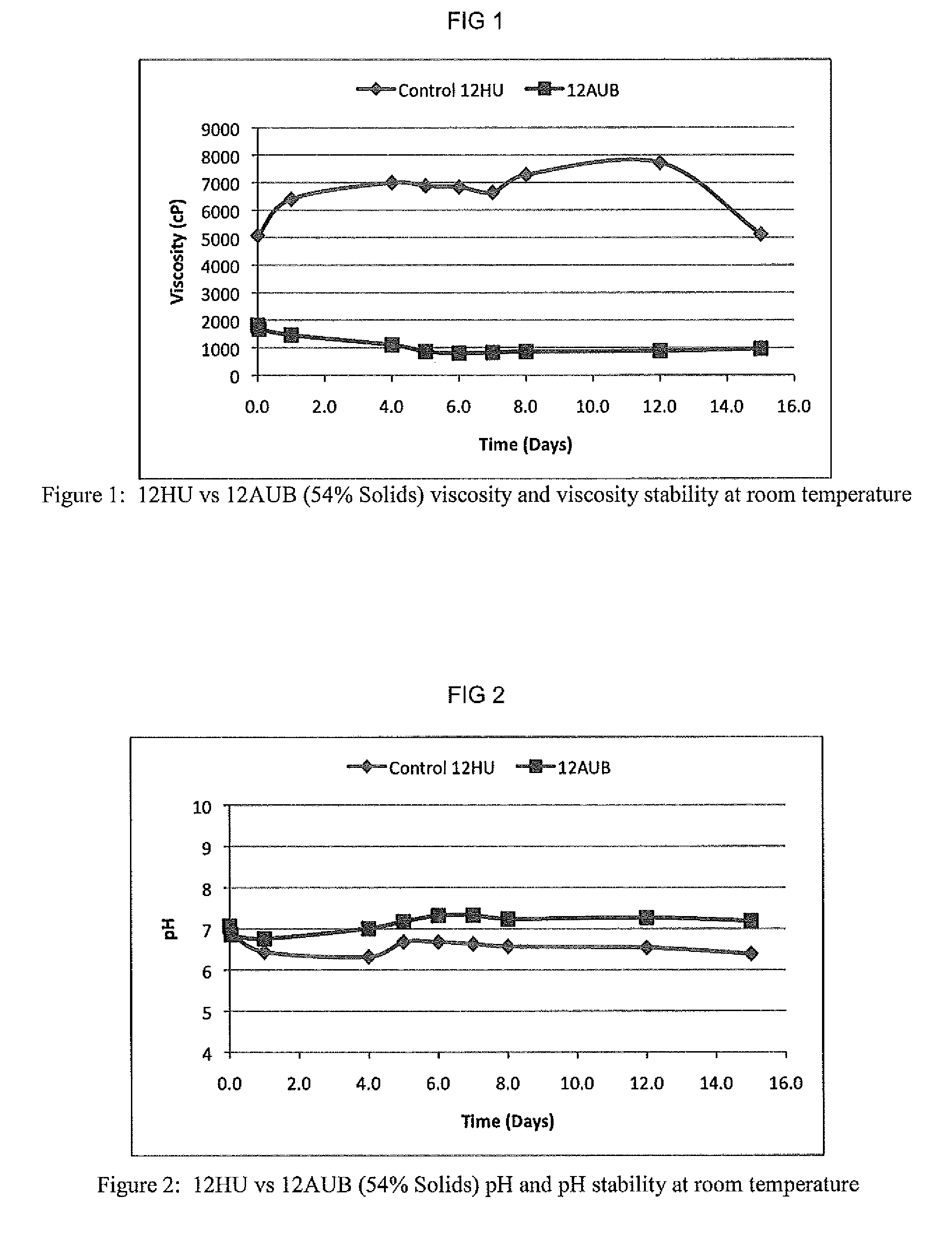Stable acid denatured soy/urea adhesives and methods of making same
a technology of acid denatured soy/urea and adhesive, which is applied in the field of composition and method of making stable adhesive, can solve the problems of reducing performance, limiting the use of soybean adhesives in interior applications, and common in the prior art soybean adhesives exhibit limited pot life, etc., and achieves excellent stability, high solids, and compatibility.
- Summary
- Abstract
- Description
- Claims
- Application Information
AI Technical Summary
Benefits of technology
Problems solved by technology
Method used
Image
Examples
example 1
Comparative Example #1
Non-Denatured Soy / Urea Adhesive (11U-26)
[0074]Soy flour when combined in water contains a significant amount of active urease that rapidly reacts with urea to produce ammonia. The ammonia is observed through a rapid pH increase to a pH of around 9 and then by the evolution of ammonia gas from the system. In one example, a 15% solution of Soy Flour-90 was prepared at room temperature with a pH of 6.2. Urea was added at an approximate amount of 1 part urea to 1 part soy flour and the pH rose to 8.90 in less than 10 minutes. After 20 minutes the pH was 9.2 with a very strong ammonia smell. This sample is not stable and is not considered acceptable.
example 2
Comparative Example #2
Heat Denatured Soy / Urea Adhesive (12HU-54)
[0075]Soy flour was heat-denatured and then combined with urea to produce stable soy / urea aqueous products per the method described by Wescott (U.S. application Ser. No. 11 / 779,558). The formula used for this experiment is provided in Table 1.
[0076]Preparation Procedure: Water was charged into a three-neck round bottom flask equipped with a heating mantle, temperature controller, reflux condenser and mechanical stirrer. The sodium bisulfate was added to the water at room temperature followed by the addition of the soy flour over a period of five minutes. The mixture was stirred for five minutes to homogeneity and then heated to 82° C. denaturing temperature over thirty minutes. The reaction was held at the set temperature + / −1.0° C. for one hour with stirring at which time the heat was removed and the urea was added to the heat denatured soy and held for an additional 15 minutes with stirring. The addition of the urea c...
example 3
Acid Denatured Adhesive—Soy / Urea=1:2 @ 54% Total Solids (12AU-54)
[0078]Soy flour was acid-denatured and then combined with urea to produce a stable soy / urea aqueous product. The formula used for this experiment is provided in Table 2.
[0079]Preparation Procedure: Water was charged into a three-neck round bottom flask equipped with an overhead mechanical stirrer. The sodium bisulfite was added to the room temperature water followed by the addition of the soy flour over a period of five minutes. The mixture was stirred for 30 minutes at room temperature (Viscosity=2800 cP w / RV#5, pH=6.03). The acid (50% sulfuric acid) was then added drop-wise to the rapidly stirring mixture until a pH of 3.0 (referred to as the acid denatured pH) was reached and, subsequently, held for an additional 30 minutes. The urea was then quickly added to the rapidly stirring acid denatured soy mixture and allowed to stir for 5 minutes. The addition of the urea cooled the soy adhesive; so the adhesive was warmed...
PUM
| Property | Measurement | Unit |
|---|---|---|
| temperatures | aaaaa | aaaaa |
| temperature | aaaaa | aaaaa |
| temperature | aaaaa | aaaaa |
Abstract
Description
Claims
Application Information
 Login to View More
Login to View More - R&D
- Intellectual Property
- Life Sciences
- Materials
- Tech Scout
- Unparalleled Data Quality
- Higher Quality Content
- 60% Fewer Hallucinations
Browse by: Latest US Patents, China's latest patents, Technical Efficacy Thesaurus, Application Domain, Technology Topic, Popular Technical Reports.
© 2025 PatSnap. All rights reserved.Legal|Privacy policy|Modern Slavery Act Transparency Statement|Sitemap|About US| Contact US: help@patsnap.com



